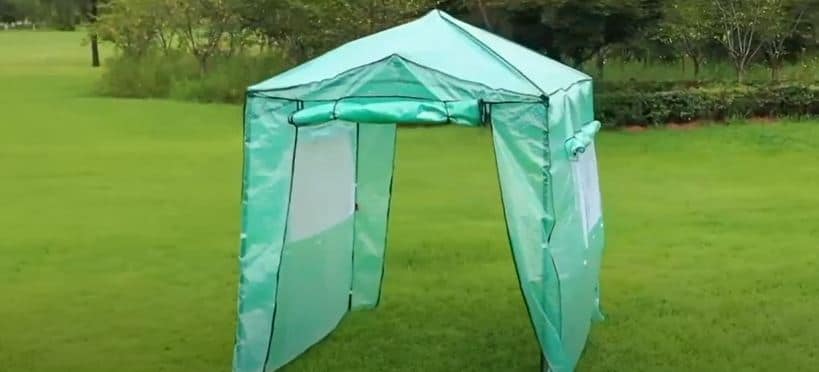A greenhouse is a great asset for any gardener without any doubt. Apart from gaining maximum yield, you can grow multiple crops throughout the year, protect the plants under extreme climatic conditions, and so much more.
The best thing about a garden greenhouse is, that it provides the opportunity to grow different types of plants throughout the year, which is heavenly to a gardener. It means you can make the best use of this compact space to achieve more yield at the same time, saving money.
Greenhouses are ideal homes for your plants to protect themselves from too chilled weather that they don’t like. They trap the required heat and humidity that the plants need and make them feel at home.
So, You’re Thinking About Purchasing the Best Greenhouse For Your Needs?
Usually, greenhouses are used to protect outdoor plants from a particular season. But they can also be used to transfer ‘indoor-raised warmth-loving plants’ to outside, as they keep things warm.
No matter which purpose you’d want to use your greenhouse for, you’d want to make sure you buy a good outdoor greenhouse kit that gets the job done for you.
Nevertheless, choosing the right greenhouse is not a piece of cake. This is one hell of a tricky job since you need to consider a lot of things before making a decision.
That’s why I have herein provided in-depth information on home greenhouse kits alongside the reviews on the best models on the market. Because
Picking the best one is more about understanding greenhouses better and identifying your needs, more than the product itself. So, check out the knowledgebase section as well for more details (After Product Review Section)
In this article, we have provided an in-depth greenhouse kit review of some of the bestseller models alongside a buyer’s guide for an informed purchase decision.
Comparison Chart of Greenhouse Kits
| PRODUCT | FEATURES | ||
|---|---|---|---|
 | Best Overall Palram HG5508G-1B Hybrid Hobby Greenhouse | • Frame aluminum • Covering polycarbonate • Size 97.2 x 72.8 x 81.9 inches • Weight 92 pounds | Price Please |
 | Exaco Victorian J-VIC 2496 | • 3" high foundation frame • safety glass • Size 150 x 93 x 100 inches • Weight- 807.4 Pounds . | Price Please |
 | Gardman R687 4-Tier | • Frame Steel • Covering clear polyethylene • Size 19 x 27 x 63 inches • 11.2 pounds | Price Please |
 | Best Lean-To Palram Hybrid Lean Greenhouse | • Frame polycarbonate • Rust resistant aluminum frame • Size 96 x 49 x 88.6 inches • Weight 61 pounds | Price Please |
 | Best Portable Quictent Portable | • Frame steel • Covering polyethylene • Size 118.11 x 98.43 x 106.3 inches • Weight 15 pounds | Price Please |
 | Quictent Heavy Duty | • Frame steel • Covering polyethylene • Size 236.22 x 118.11 x 78.74 inches • Weight 26 Pounds | Price Please |
 | Rion Grand Clear | • Frame Heavy duty resin • Covering polycarbonate panels • Size 251.6 x 105.1 x 93.5 inches • Weight 431.2 Pounds | Price Please |
 | Best Choice Products SKY1917 | • Frame steel • Covering heavy-duty pastic • Size 180" x 84"x 84"inches • Weight 61.3 pounds | Price Please |
 | Abba Patio Large Walk | • Frame steel • Covering transparent PE • 72.83 x 9.84 x 9.84 inches • Weight 79.2 Pounds | Price Please |
Best Greenhouse Kits
01. Best Bang For The Buck: Palram HG5508 Hybrid Hobby Greenhouse
- TWO PANEL TYPES PROVIDE ULTIMATE BALANCED GROWING CONDITIONS...
- STURDY THOUGHTFUL CONSTRUCTION WILL LAST A LIFETIME - Chosen...
- STEP-BY-STEP DIY INSTRUCTIONS DESIGNED FOR HOMEOWNER...
The Palram Hybrid greenhouse brings you the best of both worlds; a durable aluminum-made 6′ wide frame that is designed perfectly for your growing needs in smaller spaces, along with the precise balance of twin-wall polycarbonate covering.
Materials, Design & Features
The 4-mm thick twin-wall polycarbonate is amazingly strong, and it is virtually unbreakable.
The roof polycarbonate blocks up to 99.9% UV rays and eliminates the risk of plant burn by diffusing sunlight. The side panels made with crystal clear polycarbonate will provide 90% light transmission.
The aluminum frame looks elegant and it’s rust-resistant, so it will last longer. The frame combined with a heavy-duty galvanized steel base lays a strong foundation and structural support.
The space inside is pretty generous but not as large as the Climapod. It offers around 48 sqft of growing space that I think will be enough for most hobby gardeners.
If it isn’t, then you should go for any larger greenhouse like the Climapod’s Virtue Kit or Palram’s very own Hobby Series that I’m going to review below.
The greenhouse helps sustainable irrigation, with an integrated rain gutter that channels the water.
It has got a lockable door handle and a magnetic door catch. You’ll get a single roof vent with it that helps to moderate temperature & airflow maximizing growing conditions.
For additional convenience, there are 10 polypropylene-made plant hangers included with it that you can use to hang baskets or to support vine crops. This can help to install shade cloth to the inner frame of the greenhouse as well.
The assembly this time is pretty simple, not like the Climapod virtue. But it can be a bit difficult to understand the instructions. If you are a novice, it is worth taking professional help. Expect the greenhouse to seem very flimsy until you completely assemble and anchor it.
- Easy to assemble
- Sturdy anchor
- Well-engineered smart design
- Affordable starter kit
- Does not blow away by strong wind
- Thin panels cannot withstand extreme conditions
Bottom Line
Overall, I did not find any major drawbacks in this standard-sized backyard greenhouse kit. It has a polished neat look and offers a lot standing at such a price point. Undoubtedly, it’s the best bang for your buck.
02. Best Overall: Exaco Junior Victorian Greenhouse
- Greenhouse includes 3" high foundation frame, two roof...
- Included safety glass is 4 mm thick
- Aluminum Profiles are larger, thicker and stronger
The Junior Victorian Greenhouse is one of the premier greenhouse kits for sale with aesthetically beautiful looks. Thanks to the high-quality aluminum frame that adds to the sturdiness of the entire structure. Aluminum is the best option for greenhouse framing that comes at decent pricing. Good job!
Materials, Design & Features
The premium aluminum frame not only looks astonishing but also makes the house sturdy. The polycarbonate covering is one of the strongest in the series as well, with a 6-mm thickness.
Overall, the construction material and engineering have made Exaco Junior Victorian J-VIC an amazingly tough greenhouse. According to the users, it can withstand strong winds blowing at a speed of more than 70 miles an hour for two straight days, without getting any scar. That’s impressive.
The European-style greenhouse has two sliding doors with a magnetic key locker which tends to work smoothly without any complaint.
It has got plenty of space in it, with a measurement of 150 x 93 x 100 inches. This will be more than enough space for any hobby gardener.
This is a complete greenhouse kit that comes with the frame, 3″ frame extension. On top of that, 4 mm tempered glass windows, sliding frame door, and two opening roof windows take this model to the next level.
- Easy to assemble
- Great insulation material
- Good roof load capacity
- Extended 15 years warranty period on applicable parts
- Suitable for freestanding and anchoring as per need
- Very expensive model
Bottom Line
For the downside, I thought assembly could’ve been easier. With the current configuration, assembling the house is not a piece of cake. Though you’ll need to assemble once only.
03. Best Mini GreenHouse: Gardman 4-Tier Mini GreenHouse
- Ideal for small backyards or homes where space is an issue;...
- Gives seeds, seedlings, and young plants an early start
- Clear polyethylene cover and roll-up zippered door for easy...
If you’ve got your space at a premium, you might be looking for the Gardman 4-tier mini greenhouse.
At just 27″ Length x 18″ Width x 63″ Height, this is one of the best small greenhouse kits. This greenhouse has a small footprint and accommodates four 18″ deep shelves offering decent gardening space for you. It is an ideal greenhouse for homes or small backyards where space is an issue.
I saw that some people have used this mini greenhouse even indoors. But you have to be cautious about the fact that this grow house has no floor at the bottom, so without you installing one yourself, there can be issues with dirt and water all over your floor.
There might not be a floor, but it has a convenient roll-up zippered door for easy access.
Materials, Design & Features
Gardeners have mentioned that the PVC used as a cover in this one, does a terrific job of holding in both humidity and heat.
The good thing is, Gardman themselves sale the covering of this house separately, so you won’t have to replace the whole house if the cover gets damaged due to any incident.
This is an ideal compact greenhouse for giving your seeds, seedlings, and young plants an early start. But this one is not for serious gardening tasks in winters.
It’s constructed well with a strong powder-coated tubular steel frame that is engineered for simple push-fit assembly without requiring any tools.
This house is made for small plants and seedlings, which it can carry pretty easily. If you need to warm larger plants, consider investing in a larger house.
If I had to ask for any enhancement on this grow house, I’d like to see a vent at the top of this house, this is something it lacks. Also, though it’s not too wobbly, it is not super stable as well.
- Durable sturdy plastic cover
- Compact design
- Space saver grow racks
- Easy to set up
- Requires zip ties on the shelves to keep the containers
Bottom Line
If you buy a unit of this, I suggest you place it on something you have laying around which will help it to be more stable on the floor. You can also use hooks to zip it with any sturdy support around.
04. Best Lean-To GreenHouse: Palram Hybrid Lean Greenhouse
- Virtually unbreakable 4 mm twin-wall polycarbonate roof...
- STURDY THOUGHTFUL CONSTRUCTION WILL LAST A LIFETIME - Chosen...
- Rust resistant aluminum frame extends 7'-5" from floor to...
If you particularly want a lean-to backyard greenhouse then Ogrow’s lean-to greenhouse is the best choice for this category. This will fit at the back of your house, garage, outer wall, or any other structure that you want to attach it to.
Materials, Design & Features
This 54” by 86” lean-to house will add 25 sqft of growing space onto any existing structure you have. You can help protect tender vegetation and have easy access to your plants by situating your plant house close to a building.
The frame is made of 0.8mm thick aluminum with a steel base plinth for support. Together they lay a solid, shockproof structure for the 4mm thick twin-wall polycarbonate covering that offers good insulation from frost.
And the whole frame has got a green coating on it to prevent rusting, fading, or tarnishing.
Being sturdy itself alongside the support of a building or structure, the greenhouse is tougher against storms and hazards.
The polycarbonate is very efficient in retaining heat so the heating cost is low for this greenhouse, good enough to cut down the costs on your electricity bill. The covering can ensure an even temperature within the range of -25° to 60°C, creating an ideal growing environment.
The smooth sliding door on this helps you to utilize the whole space inside the house. The roof vent ensures constant airflow which is significantly important for successful greenhouse propagation, and along with the sliding door, it allows full cross ventilation.
And, the rain gutter allows you to capture and use the natural rainwater for irrigation.
The assembly takes time. You’ll need to patiently follow the instruction and assemble it, only once though.
- Sturdy long-lasting polycarbonate panels
- Panels trap maximum sunlight
- Occupies small space
- Compact design
- Rust-resistant frame and wall mount
- Hard to assemble without professional help
Bottom Line
If you are looking to purchase a lean-to greenhouse, this amazing package from OGrow is a choice that you can’t go wrong about.
05. Best For Growing Enthusiast: Palram Snap & Grow Series Hobby Greenhouse
- Item may ship in more than one box and may arrive separately
- Crystal clear virtually unbreakable polycarbonate roof and...
- Reinforced, double wall & rust resistance aluminum frame
Available in multiple sizes, the Palram Snap & Grows hobby series can be a great choice for growing enthusiasts.
This greenhouse helps your plants to harden themselves automatically from day one, which makes them tougher against the harsh outdoor environment that they have to face after the relocation. This also helps to reduce the risk of losing plants after transplanting.
Materials, Design & Features
The frame is made of aluminum which gets the support of the galvanized steel base. It’s rust-resistant having an extended lifespan.
The polycarbonate used on this house is made with only virgin materials that won’t become brittle or turn colors over time, as gardeners reported.
The chances of plants getting burnt inside this are very minimal, thanks to the over 90% transmission of light at 100% UV protection ability of the polycarbonate.
Integrated rain gutters work well to efficiently disperse the rainwater that can be collected for a sustainable irrigation system.
The roof vent and split door design together ensure added ventilation by keeping the oxygen flowing.
However, the shelves are not included in the package, so keep in mind that you’ll need to purchase them separately if you need them.
Like all the other greenhouses, assembling this is not an easy or one-person task.
This kit offers SmartLock connectors that snap the frame into place and polycarbonate panels easily slide into its channels, which most of the greenhouses don’t offer.
Yet you need to ensure that you install it on a leveled piece of land and a helper is there to assist you out with things. Also, don’t forget to wear cut-protective gloves as the aluminum frame and polycarbonate has sharp edges.
- Durable and robust roof and wall panels
- Convenient for commercial gardening
- Rust-resistant frames
- Clear view panels
- Allows maximum sunlight through the panels
- Easy to assemble
- Highly expensive kit
Bottom Line
To sum up, I think it’s a great option for growing enthusiasts, having no major drawback, and comes in multiple space options for satisfying everyone’s needs.
06. Quictent 2 Doors Portable Greenhouse
- 2 Doors & 5 Vents---- Metal zippered front & back door allow...
- Overlong Cover Design---- Korea imported polyethylene cover...
- Stable Construction---- Heavy-duty powder coated steel...
If you love to have a starter greenhouse kit that comes with large, lightweight, walk-in features, this model is for you.
Materials, Design & Features
Frames of this greenhouse are crafted with heavy-duty powder-coated steel. Sturdy steel frames including middle rails for additional stability made this house capable of coping with adverse weather. You can strengthen the base further with 12 stakes coming along with the packages.
The cover used on the house is UV protected, 100% waterproof transparent poly material. Made of premium reinforced PE leno quality material, this cover is much stronger than regular poly. Having features like two zipped front and back doors with five side vents help to increase ventilation.
The white cover has been used to increase the light reflection to give an extra boost to your lovely plants. Moreover, it has an overlong cover design making the house light and secure.
When you think of better growth of your plants, especially a few huge plants, this house can be a good choice as the height of 7.84’ allows more space for your big plants to breathe conveniently.
This house does not require heavy tools, in-depth engineering knowledge to set up. It will take only a few minutes to install. Just bury it in the soil!
- Large and portable
- Cost-effective grow tent
- High-quality PE covers
- Sturdy rust-resistant frames
- Easy assembling
- Greater stability
- Superb waterproofing
- Open zipped doors evacuate heat during winters
Bottom Line
However, if you have the chance to face strong wind or a bit of storm very often, I would suggest purchasing additional anchoring materials (stakes, weight screws, etc.) to make your house more stable against this rough weather.
07. Best for Large Plants: Quictent 2 Doors 20 Stakes Heavy Duty Portable Greenhouse
- Upgraded Greenhouse 2 Mesh Zipper Doors & 8 Vents--2 Doors...
- Reinforced Mesh PE Cover--heavy duty 2 layers PE cover with...
- Powder Coated Steel Frame--heavy-duty powder coated steel...
Do you think something huge for your big plants?
If you are planning to go with big plants in a spacious house without compromising with lightweight and durability, you should probably go with this house. Quictent 19.7’x10’x6.6′ Portable Greenhouse is a larger house allowing your big plants to grow properly.
Materials, Design & Features
The powder-coated steel frame including middle rails gives additional strength offers a prolonged lifespan. On top of that, ten bases and 20 stakes are supplemented with a package that helps to increase the resistance against snow and wind.
Improved Poly Ethylene Leno cover material is much stronger than typical materials that can prevent the covers from tearing or destruction. The PE cover not only provides a stable shelter but also the perfect environment for your plants and herbs.
Roll-up double doors including eight pcs mosquito windows keep the breeze flowing at the desired level. On the other hand, the extended cover design provides better closure with higher humidity & temperature for growing your plants and herbs.
A good part of this house is that, even after being such a huge house, it takes only a few minutes to set up without using any tools.
You will get a replacement for any defective parts of this greenhouse from the supplier without any charge.
However, if there is any chance of a massive wind/storm in your area, you need to take precautionary action, ie attaching an extra anchor, screw, etc.
Don’t allow the front face of the house in the direction from the wind predominately blows
Wet or windy conditions may deteriorate the greenhouse life.
- Supreme stability for windy areas
- Sturdy long-lasting mesh covers
- Easy to set up
- Large space for greater yield
- Not convenient for extreme winter zones
08. Best Greenhouse For Winter: Rion Grand Gardener 2 Clear Greenhouse
- Virtually unbreakable 4 mm thick twin-wall polycarbonate...
- Clear polycarbonate side panels offer classic style without...
- Quick and easy assembly with a simple pin and lock connector...
The Rion Grand Gardener Greenhouse is robust and ideal for the blustery, wet weather, and snow load.
The best part of this house is, it comes with heavy-duty resin frames that withstand extremely severe winters, high winds, and they won’t bend or discolor either.
Materials, Design & Features
It is considered a “top of the line” greenhouse as this house has been re-engineered to make heavy-duty and long-lasting by increasing thickness of panels from 4 mm to 6mm made of 100% UV protected polycarbonate. These materials make this greenhouse great providing extra durability for many years to come.
A barn-style roof design carries plenty of headroom and gives more space to your plants.
You can quickly assemble using the Pin and Lock connectors, while the roof panels now merely slide into place. An optional base kit will give you a solid foundation and extra stability against the strong wind.
However, it is recommended to set this greenhouse on a concrete pad or a heavy timber foundation to prevent mess and soggy mud on the ground.
Nevertheless, you may find this house a bit expensive compared with other typical styles, but when you notice the extraordinary and unique features of this house, you would agree that spending money on this model is reasonable.
- Affordable
- Unbreakable polycarbonate roof panels
- Made for heavy snowfall zones
- Maximum sunlight penetration
- Massive gardening space
- Poorly designed door parts
Bottom Line
As a home gardener, you can be a proud guy having this beautiful Grand Gardener models- this model is not just durable, spacious, and heavy-duty but also a stunning piece.
09. Great Bang For The Dollar: Best Choice Products Portable Large Walk-In
- WITHSTANDS THE ELEMENTS: Durable PE fabric softens and traps...
- WALK-IN TUNNEL: The arched tunnel shape encloses a large...
- PROMOTES AIRFLOW: Eight roll-up windows with a zippered door...
This time I brought onto my list an excellent bang for the dollar; literally, it cost only $119, yet this kit is sturdy with massive space for large plants.
When you think of growing plants, fruits, and vegetables round the year and protecting them from various weather conditions such as rain, wind, and snow, as well as pests, this model comes to you to meet that requirement.
Materials, Design & Features
This model is weather-resistant meaning that it will protect your plants from rough climatic conditions such as rain, wind, and snow. The heavy-duty plastic cover of this greenhouse guarantees long-term protection.
Featuring a spacious design, this tool helps to grow a wider variety of plants. There are different heights between the spaces of this model that allows keeping your small and large plants side-by-side. Further, it keeps plants safe and organized by offering shelve on both left and right sides.
You will be pleased to see its heat and light management system. Zipped-door and eight roll-up windows with screen ensure and manage the required temperature and light.
The good thing is that you can walk-through due to its tunnel design. You can walk comfortably to care for and manage a large number of plants. It has an amazing size of 180″(L) x 84″(W) x 84″(H).
Though it offers a very competitive price that does not mean it comes with low-quality greenhouse accessories. Extended lasting plastic cover, rust-resistant powder-coated steel tubing, and secure guy ropes ensure worry-free ownership for years.
We have read a significant amount of reviews from real users; almost all users are happy with the after-sales services they received from the manufacturer. And no doubt, it’s a plus point!
- Durable threaded plastic covers
- Smart design and spacious
- Budget-friendly kit for starters
- Can withstand snowstorms and strong wind
- Requires additional insulation and heater for winters
Bottom Line
So, if you are on the side of the growth of a wide range of plants, vegetables, and protecting them round the year from harsh weather, you can bet on this model. Most importantly, that will be a great bang for the dollar.
10. Abba Patio Large Walk in Fully Enclosed Greenhouse With Windows
- 2 zipper door allows easy access and great ventilation for...
- Strong durable reinforced transparent PE cover protect...
- Constructed with heavy duty powder-coated Steel frame...
This model comes from a famous brand manufacturer Abba widely appreciated for sleekly designed, rigorously tested for durability, and featured assembly mechanism- super easy from start to finish. The trendy style and true artistry can withstand all adversities for years to come.
Materials, Design & Features
It comes to you with large windows that have pest-netting to protect your plants from insects. Four large windows on the long sides and a roll-up front door secured with a zipper on each end ensure convenient access through the house and excellent ventilation for plants and vegetables.
The cover has been made of stable, durable reinforced transparent PE. The sturdy powder-coated steel frame makes this model resistant to chipping, peeling, and rust.
Another plus point is that it is equipped with a big footplate that increases stability.
The crucial fact for choosing this model is that it is easy to assemble and disassemble without using any tools, and it is still portable even after assembly.
- Clutter-free design
- Pest-resistant netted windows
- Pegs and footplates provide greater stability
- Transparent PE covers allow maximum sunlight penetration
- The heated steel frames may melt the covers in summer
Bottom Line
All-in-all, it can be an excellent choice for you. If you are on the sides of the portable, lightweight, yet sturdy greenhouse, this model is for you.
GreenHouse Types – Which One Suits Your Requirement?
Basically, Greenhouses Are Of 3 Types:
The traditional freestanding greenhouse that looks like a home, the lean-to greenhouses that stay attached to any outer wall of your house, and the pop-up greenhouse that is a very mobile one and can literally pop-up anywhere.
Free-Standing Greenhouses
The free-standing greenhouses are the most commonly used type for gardening. These are like a separate house that has its structures and covering, obviously.
The most common shape for freestanding greenhouses is the A-Frame shape, followed by the round-arch shape.
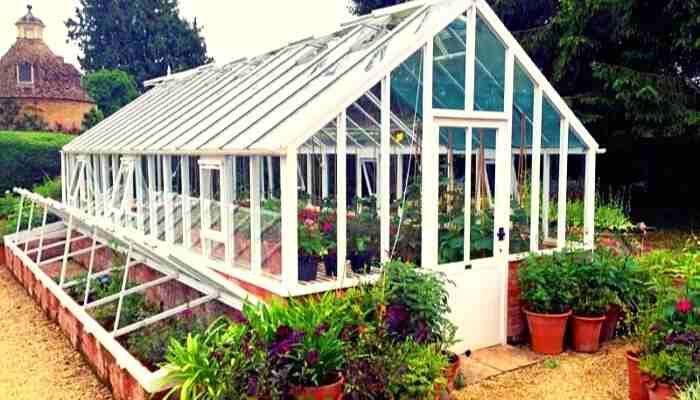
A-frames allow you to use glass or any other material as covering material. Whereas round-arch allows all, except glass, since they can’t be bent.
Free standings models are the most expensive ones and these are for serious gardeners. This has a professional look in itself and offers a proper greenhouse gardening environment.
These are spacious and contain many plants inside. These usually have multiple bed options.
But they’re usually the most expensive options as I just mentioned, both for buying and maintaining.
Lean-To Greenhouses
The lean-to greenhouses stay attached to any of the outer walls of your house. These usually do not have much space inside.

They’re small greenhouse kits good enough spacious to make room for a little bunch of plants, but usually not for all the plants that a serious gardener tends to have.
That’s why I don’t recommend them for serious gardeners. They’re good for casual and occasional gardeners though, that doesn’t tend to have many plants.
They’re usually cheaper than the traditional freestanding ones since you need less material to build them.
However, sometimes it can get more expensive than freestanding ones because many people tend to use richer wooden frames to build it since it’s attached to their house and they want it to enhance the beauty of their house.
They can get more energy-efficient since they can fetch some sort of heat from the rooms of the house. But they’re not mobile at all, which may be a downside of these greenhouses.
These are for gardening enthusiasts who’d like to have some plants closer to their room and wants to spend lesser money as well.
Pop-Up Greenhouse
The pop-up ones are the ultra-mobile greenhouses that look like the freestanding ones when in action, but smaller in size.
You can set it up whenever you need them, and pack it away when you don’t need them anymore.
You can also set them anywhere you feel like, and this makes it easy to get the right amount of sunlight by syncing its position with the sunlight positioning.
Along with mobility, convenience, set up and set away, the pop-up ones are versatile in size as well. They come in different sizes to fulfill different expectations.
They’re not a permanent addition to your home as well and you can store them in the offseason or whenever you don’t need it.
As expected, they’re the cheapest one, not by a tad difference, but by a larger margin.
They’re for people who’re looking for a temporary solution for spring or fall, or for someone who’s just looking to overwinter plants by spending as little as possible.
Greenhouse Size: How Much Space Do You Need?
Before buying a greenhouse, one of the most crucial decisions you need to make is determining the size that you need to buy.
You don’t wanna spend a lot on a giant greenhouse that you won’t need.
But things get even more inconvenient if you buy a greenhouse smaller than you need since you won’t be having adequate space to grow all your plants.
Now, by ‘smaller than you need’, I don’t mean your current need for space. If you buy one that has roughly the space that you need now, it’ll feel smaller after some days, I bet.
Because most hobby gardeners feel the urge to add a plant or two after little intervals and not being able to do that will lead them to real dissatisfaction.
So, take a life-saving tip from me, and always buy a greenhouse that is 25-40% larger than your current space requirement. You’ll thank me later.
However, you’ve to determine your current need for space for all your plants. First, we have to calculate that, then we can think of buying a greenhouse 25-40% larger than that.
When it comes to width, you want to have 19 inches or more for the paths if you’ll be only walking through that. Make it 5-6 inches wider, around 24-26 inches if you need to bring equipment often and you get visitors often too.
The width of the bed should be that much to provide easy accessibility when standing by the side of it. This is the case where the walking path is between the two beds and you can access the beds from one side of it only.
If you can access the bed from both sides of it, which means the bed is standing in the middle and two paths are surrounding the bed, you can double the width of the bed, since you can reach the middle standing from either side of the bed.
So being able to reach the middle from both sides will cover the whole bed.
The next step is deciding the length of the house.
You’ll need to decide this considering how many plants you’ll need to keep inside the greenhouse. You want to keep 1 sq. foot of space for every 6” pot.
And as I mentioned earlier and taking the liberty to mention again, is, buy a 25-40% larger than the one you think you’ll need.
It is cheaper (may look expensive upfront) than expanding the greenhouse or buying a new one later, which is a task full of hassles too.
What You’ll Be Using The Greenhouse For?
The purpose that you want the greenhouse to serve, has a lot to do with your buying decision. People have their reasons for buying a greenhouse. Like they say –
I Want to Get a Few Extra Growing Weeks in Late Fall/Or a Head Start In Early Spring: This is one of the basic tasks for a greenhouse and a piece of cake to it. How much extra time can you get with the help of the greenhouse mainly depends on your local climate?
Greenhouse features like automatic ventilation and heating are also helpful to better serve the purpose.
All of the greenhouses that are available on the market can serve this purpose. If this is the reason, you’re buying a greenhouse, any basic model will do it for you. You don’t have to invest your money in any particular expensive & feature-packed greenhouse.
I Want to Overwinter Plants: In such a case, you’ll need a greenhouse that allows artificial heating. To help plants that are vulnerable to winter, you’ll need to warm the greenhouse with third-party heating, even if it is for a short period.
These types of greenhouses are suitable for season-extending as well.
Now, which greenhouse to buy depends on the indoor-outdoor temperature difference and the precise heat that you’ll need to maintain inside the greenhouse. If you think around 30° F above the outside temperature will do fine for you, you can afford to buy inexpensive greenhouses like the Flower-House models.
But if you live in even a colder climate where the temperature sometimes drops to 0° F or below, I’ll recommend you a greenhouse with an insulated covering.
The good thing about these greenhouses is, they retain heat better as their primary job, also generally gets heated easier with less energy consumption, because of the tighter seal they have.
I Want My Plants to Grow In Winter, Just Not Survive: Plants usually need higher temperatures to grow and thrive than they need just to stay alive. So if you want your plants to even grow during winter, consider buying a premium insulated greenhouse that gets warmer and retains heat better.
The models I mentioned in the previous point like the Climapod, Monticello Premium, the Palram, etc. are good enough for this job. Yes, they are a bit expensive, but they are worth the extra investment because of their performance and the lower heating cost.
I Want a Greenhouse to Grow Plants All Year Round: This is a different scenario because this time it’s not only about getting more and warmer, it’s about maintaining the heat better.
Yes in the winter the greenhouse will need to get warm enough to let the plants grow and thrive. But if you decide to leave them like that in the summer as well, the plants will get fried.
So the greenhouse needs a smart ventilation system to let some heat go in the summer.
That’s why I recommend a greenhouse with an evaporative cooling system to serve this purpose better. They know how to keep temperatures to a minimum when it is hot outdoors.[/su_spoiler]
Selecting The Perfect Place For Your GreenHouse
Buying a quality greenhouse is not enough, placing is crucial too. Site selection has a lot to do with the effectiveness of the greenhouse.
Sunlight: You have to consider multiple things to choose the best location for your greenhouse. While the sunlight is a major consideration, other things like availability of afternoon shade, accessibility, drainage system, water source, etc. are important factors too.
The best location for the greenhouse is southern exposure. This exposure gets no shade throughout the day.
The next best location is the south-east or eastern exposure, followed by the south-west or western exposure. These locations get some shade in the morning or afternoon but get the sunlight throughout the rest of the time of the day.
The least desirable location for greenhouses is the northern exposure since this place gets some shade almost all day long, so lacks the sunlight that the plants need.
Orientation is important too. A greenhouse that’s oriented east-west gets less light than the one that’s oriented north-south.
Now that you know how much light you’ll get placing it where you need to know how much light you desire, and that depends on what you’re building the greenhouse for.
If you’re going to use the greenhouse primarily for plant propagation or starting seeds and transplants in the summer, you want to minimize heat buildup.
So you desire less light. Try to place it in the eastern or western exposure which gets some shade during the day.
If you have to place it in the southern exposure for some reason, consider providing some shade to control the amount of sunlight that reaches the interior, maybe with a shade cloth.
If you want to use the greenhouse for growing in winter and late, or growing your plants to maturity, you’ll want to provide it maximum exposure to the sun.
Ensure your plants get sunlight for a minimum of 6 hours. The best orientation in such a case is east-west. This helps to gain more heat from the sun during the winter and create less shadowing in the greenhouse as well.
Afternoon shade from a deciduous tree is a really desirable thing for a greenhouse. In the summer, they can shade the greenhouse during the hottest part of the day.
And in the winter, the leaves will fall and the greenhouse will get the extra light that it needs during the entire day.
Though, be aware of placing the greenhouse very close under the tree. There’s a chance of falling branches that might damage the house. Place the house adjacent to the tree, but not too close or directly under it.
If the natural afternoon shade option is not available, you should put the effort to manage artificial shading only for the afternoon.
Accessibility and Utility Supply: You want to make sure that your greenhouse is easily accessible. Don’t forget that you’ll need to move fertilizer, soil, plants, and yourself obviously, to and from the greenhouse. The more accessible it is, the easier your gardening life will be.
A good site for your greenhouse should be sheltered from high winds and easily accessible for you from both your home and garden shed.
Access to utility supplies like water and electricity are important considerations too. You want to select a site where you easily can ensure a fluent water supply.
Also, make sure the electricity line reaches there easily too. You’ll need to run fans and provide artificial heating in need.
Last but not least considerations are good drainage systems and a possibility of storm damage. Just like you ensured water comes in easily, in the same way, ensure it leaves the place easily as well.
If water stays stuck within or around the house, the plants will not be really happy with it, as it can damage them and create a mess in the house.
And greenhouses are prone to damage caused by natural storms. So select a site where the impact of the storm is not severe and you can take quick action to protect the house in an emergency.
Materials Of The Greenhouse: An Important Factor to Consider
Not surprisingly, the materials used to manufacture a product play the most important role in its performance. But in the case of greenhouses, the manufacturing element is not only about performance, but also functionality.
That said, there are no certified ‘best’ materials for greenhouses. There are so many materials that are required to build a greenhouse, so it is hard to know what’s best.
Aluminum, wood, galvanized steel, PVC, fiberglass, glass, polycarbonate, polyethylene, etc. all have their place in the construction of a greenhouse. So it’s your budget and functionality needs that will determine which is best for you.
Green House Coverings:
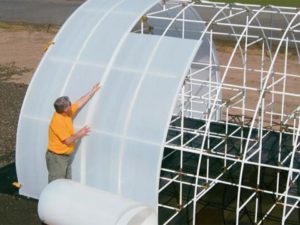
The most important thing for a greenhouse is covering which determines the amount of light that’ll go through to your plants, and the amount of heat the interior will retain.
Additionally, it’s responsible for how your greenhouse looks, its security and longevity, ease of maintenance, and so on.
Some common materials used for greenhouse covering include glass, fiberglass, polyethylene, polycarbonate, etc. Each has its advantages and disadvantages. Let’s see what those are.
Glass for Greenhouse:
Glass is the most traditional greenhouse covering, which is mostly preferred for its permanence and beauty. A glass covering is likely to serve you more than 25 years if not accidentally broken, twice as much as any other covering material.
Glass is not really amongst the most efficient materials for retaining heat, because it transmits heat and gets cold quickly, and has very little insulating value.
Greenhouse glasses need to be double or triple in strength to increase the heating efficiency and decrease breakage chances which may occur when installing, and in a completed greenhouse as well.
The glass is the heaviest material amongst the ones that are used for covering, so it needs more substantial framing. The frame needs to be sturdy to hold the glass covering.
There are other disadvantages like they don’t diffuse light, so there can be a risk of burning plants. They’re more likely to break than plastic covering. This is a considerable issue if you have kids playing basketball in the surroundings or trees nearby, etc.
Finally, installing glass is not a piece of cake. Slight deviations from vertical and horizontal frame alignment or settling of the foundation may crack it.
It is good to avoid using glass as the frame in most DIY greenhouses kits may not be that rigid in the very first place. Moreover, it is a tough chore to place the glass so you need to be very careful.
If you still want to have glass material for its beauty or any other reason, consider hiring an expert to take care of the installation.
Plastic Material For A Greenhouse:
The distinct advantage of plastics like fiberglass, acrylic sheets, polycarbonate, and polyethylene film is that they’re shatterproof, and they resist hailstone damage.
Also, their flexibility helps a lot. You can flex them to fit over a curved surface, which lets you design the frame in a rounder shape if you need it.
And they are available in large sheets, which reduces the possible number of joints in the covering, and ultimately reduces the possibility of air leaks from the joints.
Fiberglass:
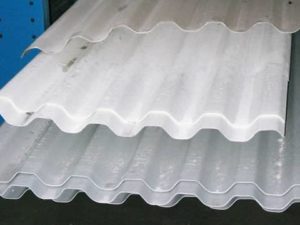
Fiberglass is considered to be the first of the practical replacements for glass. They come in corrugated sheets or rolls usually.
Fiber Glasses are translucent rather than transparent. They’re see-through but the light transmission is lesser than glass.
Fiberglass creates a virtually shadow-less greenhouse by diffusing the light that passes through it. They’re more efficient at retaining the heat than glass, but not as efficient as insulated plastics like polyethylene film or polycarbonate.
At the same time, they transmit less heat into the greenhouse which helps in both winter and summer.
But, fiberglass is not even close to glasses in terms of sustainability.
The fiberglass used in Greenhouse is UV-protected by a coat of some sort of gel that eventually bakes under the sun lasting roughly about 6 years before turning yellow. After this time, fiberglass becomes very unsightly as dirt accumulates on the glass fibers.
Polycarbonate:
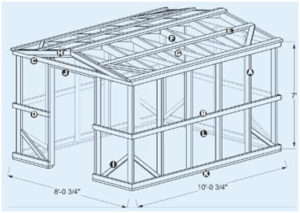
Polycarbonate is one of the latest covering options for greenhouses.
The UV treated polycarbonate offers multiple benefits, as they provide much of the clarity of glass and at the same time, they’re stronger, so more resistant to impact than other greenhouse coverings. Also, they’re more resistant to even fire than other plastics.
Polycarbonate for greenhouse covering is available in different thicknesses. Usually, you’ll find single, double, and triple-walled sheets.
They’re different in terms of the amount of heat they’re capable of retaining, so in terms of price, you can buy according to your needs and budget.
As you can guess, single wall polycarbonate is the most affordable option among all the available versions. This type of polycarbonate is mostly used for its attractive appearance.
But since it is single-layered, it lacks heat retention abilities, the strength, and light-diffusing properties of multiple wall polycarbonates.
Multiple wall polycarbonates are more expensive and come with better properties. They minimize shadow that is optimal for growing plants as they provide your greenhouse with an even diffused light.
They also retain more heat, and stronger against impacts. They’re cheaper in the sense that heating costs get lower with them. So if you’re in cold climates that need frequent heating, these expensive multiwall polycarbonates will pay for themselves.
Polycarbonates are more durable than fiberglass. They offer up to 15+ years of lifespan. Though it is still not much as glass, it’s a great number considering how lesser they cost than glass.
Polyethylene Film:
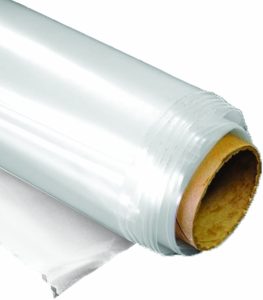
Polyethylene film happens to be the favorite of commercial growers because of its simplicity of maintenance.
Use it without any hassle for 3 to 5 years then reinstall the new poly. The lifespan of polyethylene depends on the poly thickness and UV treatment used though. A difference in these properties also creates a difference in the lifespan.
Single-layer polyethylene film is good for simple cold frames. This type of coverage is best suited for greenhouses that are used for starting seeds and other seasonal needs.
In the case of using polyethylene with multiple layers, the space between them is usually inflated by a fan that creates insulated air space. A double layer polyethylene film is more efficient in retaining heat than glasses, which saves roughly 40% in heating costs.
On the downside, polyethylene has a relatively short lifespan than other greenhouse coverings. They’re also more prone to rips and tears and have a translucent appearance much like fiberglass.
Despite these drawbacks, Polyethylene’s low cost, efficient heat retention, high light transmission, ease of replacement have made it a favorite greenhouse covering option for commercial growers and nurserymen.
All the polyethylene films are not great for greenhouse covering though. Polyethylene sold in many hardware stores is cheap and thin, which is not the best suit for greenhouses.
Polyethylene films that are made for greenhouses are specially coated for protection from UV (ultraviolet) rays, as UV harms unprotected film and reduces the durability.
Polyethylene has a little cost difference than normal films but influences a considerable difference in performance in your greenhouse. So make sure you buy the specialized ones made for greenhouses.
Greenhouse Frames:

The common materials for greenhouse frames are galvanized steel, aluminum, wood, plastic, etc. Just like the covering, they have their advantages and disadvantages, and there’s no considerable ‘best’.
It depends a great deal upon what covering you want to use, for how long you want to use it, and where and how you will be using your greenhouse.
Galvanized Steel
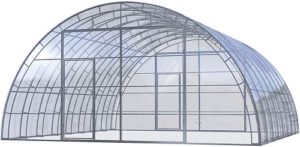
Like polyethylene films, galvanized steel is favorite of commercials for frame material, as they are low in cost, comparatively long-lasting, and require less framework (thanks to steel’s natural strength), which ensures less shadowing.
The greatest value Steel provides in greenhouse construction is its strength. Due to its natural strength, it requires way less framework and they can afford to be thinner as well, so they ensure minimal shadow and maximum light entrance.
Another major advantage of galvanized steel is its low cost.
So if you buy any steel tube greenhouse, make sure the steel is heavy-duty galvanized steel or stainless steel tubes that’ll protect it from the normal humid and corrosive (fertilizer salts) atmosphere inside the greenhouse.
Aluminum

Aluminum is the most expensive, most beautiful, and sustainable framing option for greenhouses.
They have a higher initial cost, but they pay for themselves later with the premium look and longest possible lasting as they’ll never rust, rot, or break down from UV rays.
Aluminum promotes much more sturdiness in the frame as well so they can adopt a rigid and weighty covering option like glass.
Usually, these two materials, aluminum, and glass are often used hand in hand to construct premium greenhouses like Monticello.
Though aluminum frames are sturdier as a whole, they do not have the natural strength of steel.
So it usually requires more bars or parts to build a total frame, which creates a little more shadow inside the greenhouse, as a minor downside of aluminum as a greenhouse framing material.
Try to look for engineered-shaped aluminum bars that are designed to increase frame strength, without much more parts needed.
Wood
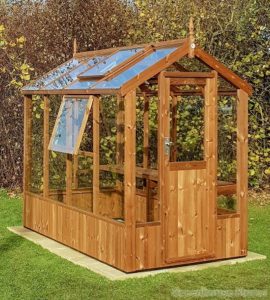
Wood is most commonly used in homemade greenhouses. Nice finished woods bring a very attractive look to the greenhouses. Also, they lose less heat compared to a similar size metal frame.
Wood frames are often covered with rigid plastic covering. A sturdy wood frame can take the load of glass covering and looks premium together.
Due to a greenhouse’s damp atmosphere, wood frames tend to have a limited lifetime before it starts to deteriorate. If you want to use wood for the framing, I recommend Redwood or Cedar as they have a natural resistance to corrosive elements and insects.
I also recommend applying a chemical sealant or stain to the wood periodically as that can help greatly to increase the lifespan of the wood.
Since wood frames tend to be heavier and larger compared to equivalent metal frames, they tend to block the light a bit more and increase the amount of shadow, which is not desirable. You’ll have to live with this drawback if you’re fond of the attractiveness of wood frames.
Plastic
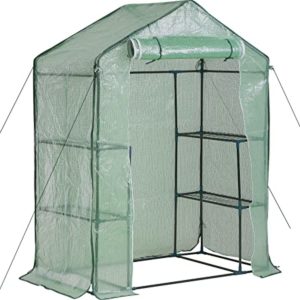
Plastic has grown in popularity as a framing material over the last 10 to 15 years. They’re low in cost, they’re portable and they are very easy to install.
But plastic is not as rigid as wood or metal so they’re usually used to construct smaller structures that don’t require a lot of strength. Though metal wire supports tend to compensate for what plastic lacks in strength.
Since plastic is even a poorer conductor of heat than wood, they lose a lot less heat compared to a metal frame, which is a great advantage.
Plastic is pretty vulnerable to ultraviolet rays which emerges as a major drawback. The UV rays coming from the sun will eventually cause the plastic to deteriorate. Even the UV protection tends to not work so well, though better than no protection.
A plastic material that is protected with UV usually has roughly 20 years of lifespan, which is not bad. Another drawback of plastic is they influence a larger shadow as they are larger than equivalent metal or wood frames.
How Does Greenhouse Work?
Understanding the process by which the greenhouse works can help you to get the most out of your set up.
Greenhouses work on a basic principle on how they trap and retain heat to promote plant growth. The wavelength of the heat coming from the sun is smaller, which can pass through the greenhouse covering material like glass, polycarbonate, etc.
The heat gets soaked up by the plants, and eventually they ‘have to’ emit it. But this time, the wavelength of the heat emitted from the plants is larger, which can’t pass outside through glass or polycarbonate.
So the heat stays to keep the room warm, which plants love.
The thing to learn here is, you can’t just choose any covering material for the greenhouse that does not follow the principle. Glass, fiberglass, polycarbonate, polyethylene film all will do fine.
Final Words
That was a long piece, wasn’t it? I had to put a lot of effort to write this one but I loved every bit of it. Since gardening is something I’m passionate about, writing anything about gardening feels like a breeze to me.
About picking the best-suited greenhouse for you, I again want to remind you that it’s more about understanding your needs and expectations from the greenhouse, than the house itself.
All the houses I recommended above are great, but not ‘best’ for ‘everyone’ out there. They all fall in the same category in terms of build quality, features, assembly, etc.
Almost every house has got aluminum frames, most use polycarbonate for covering, and assembly is not easy for none of them. What’s the difference then?
Everyone has their own best usage. One’s for entry-level gardeners, one’s for seeds and seedlings, one’s for joining with your house, and so on. You need to understand what you need.
By the way, doesn’t that mean this high-quality aluminum framing, great polycarbonate covering is there in every other greenhouse?
Not really. Some greenhouses claim such in the advertisement but do not stand up to promises in reality. That’s why I handpicked these models from every category that are true to themselves.
Judging the quality of the materials and the overall engineering of a greenhouse is important too, alongside knowing your purpose.
That’s all from me on the greenhouse kit review. Stay tuned for the next piece.










